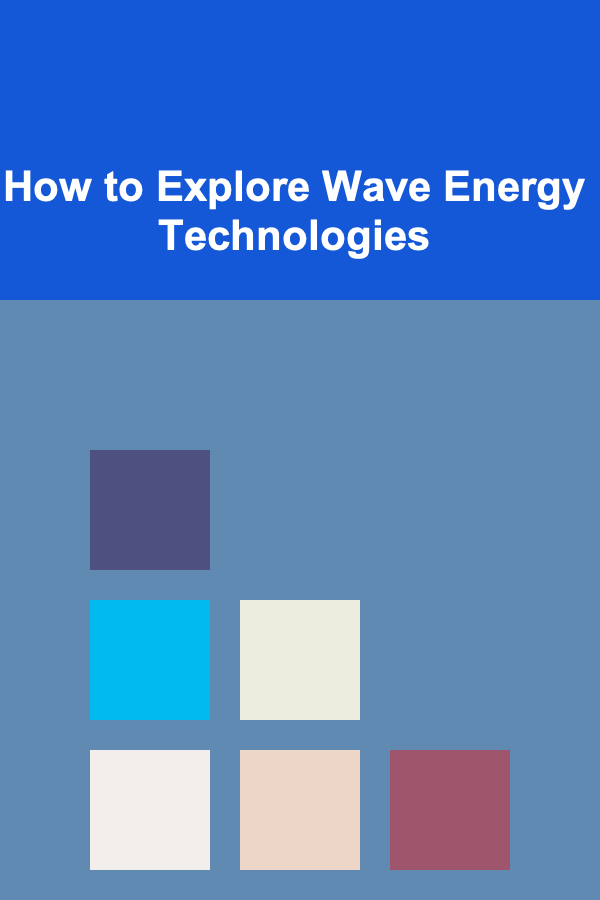
How to Explore Wave Energy Technologies
ebook include PDF & Audio bundle (Micro Guide)
$12.99$9.99
Limited Time Offer! Order within the next:

Wave energy technologies are an exciting and promising frontier in renewable energy. As global energy demands continue to rise and concerns about climate change intensify, the need for sustainable, eco-friendly power sources becomes more critical than ever. Wave energy, a type of hydropower harnessed from the movement of ocean waves, holds significant potential for providing clean, renewable energy. This article explores the current state of wave energy technologies, their potential, challenges, and future developments.
What is Wave Energy?
Wave energy refers to the energy that is captured from the surface motion of the ocean, commonly known as ocean waves. This energy is a form of mechanical energy that can be converted into electricity or used for other applications like desalination or water pumping. Unlike wind or solar energy, which are dependent on atmospheric conditions or sunlight, wave energy is driven by the movement of the ocean's surface, a highly predictable and constant resource. The movement of waves is primarily caused by the wind, though factors like tides and currents can also play a role.
Wave energy has been considered a viable source of renewable energy for many years, especially because it is abundant and consistent. The oceans cover about 71% of the Earth's surface, providing a vast area for potential wave energy generation. Additionally, the power generated from waves is much more reliable than wind or solar energy, as ocean waves occur at all times of the day and night, regardless of weather conditions.
Types of Wave Energy Technologies
There are various technologies currently under development or in operation for harnessing wave energy. These can be broadly classified into different types, each with distinct characteristics and operational methods. The three main types of wave energy devices are:
1. Point Absorbers
Point absorbers are floating structures designed to move with the waves. They are typically buoyant devices that oscillate up and down as waves pass by. The movement of the device is harnessed using a variety of mechanisms, such as hydraulic pistons, generators, or mechanical linkages, to convert the mechanical energy of the waves into electrical power.
Point absorbers are designed to be small and efficient, with the potential to be deployed in large arrays. Their main advantage is that they can be installed in deep waters, where the wave energy is most intense, and they are capable of generating power regardless of the wave direction.
2. Oscillating Water Columns (OWC)
Oscillating water columns (OWCs) are fixed devices that use the movement of water to drive air turbines, which in turn generate electricity. These devices consist of a chamber partially submerged in water, with an opening at the top and bottom. As waves enter the chamber, the water level rises and falls, creating a pressure differential between the inside and outside of the chamber. This pressure difference forces air through a turbine, causing it to spin and generate electricity.
OWCs are often used in near-shore applications, where waves are less intense than in deep-water sites but still sufficient to drive the turbines. Their advantage lies in their simplicity and ability to operate continuously as long as there is wave activity.
3. Attenuators
Attenuators are long, multi-segmented structures that float on the surface of the water. These devices are designed to follow the motion of waves, and as waves pass along their length, the individual segments move in relation to each other. The relative motion between the segments is used to generate mechanical power, which can then be converted into electricity.
Attenuators are ideal for larger-scale installations and can be used to capture energy from both deep and shallow waters. They are often deployed in long rows to capture the full potential of wave energy over a large area. One well-known example of an attenuator is the Pelamis Wave Energy Converter, which has been deployed for testing off the coast of Portugal and other locations.
4. Overtopping Devices
Overtopping devices, sometimes called "wave dams," are large, floating structures that capture waves and allow water to spill over the top of the device. The captured water flows into a reservoir, from where it can be released through turbines to generate electricity. These devices are similar to traditional hydropower dams, but they rely on wave energy rather than river flow to fill the reservoir.
Overtopping devices can be highly effective in areas with large, consistent waves, and they have the potential to generate significant amounts of power. However, their large scale and high construction costs can pose challenges to their widespread deployment.
5. Submerged Pressure Differential Devices
Submerged pressure differential devices use the pressure changes created by wave motion beneath the surface of the water to generate power. These devices are typically placed at or just below the surface of the water, where the pressure fluctuations caused by wave motion are greatest. The pressure differential is used to drive a mechanical or hydraulic system that converts the energy into electricity.
These devices can be highly efficient, especially in areas with strong, consistent wave action. However, they require careful design to ensure that they can withstand the harsh underwater environment and avoid damage from marine organisms or weather conditions.
Advantages of Wave Energy
Wave energy offers several key advantages over other renewable energy sources:
1. Consistency and Reliability
One of the biggest benefits of wave energy is its consistency. Unlike solar and wind power, which can be intermittent and unreliable, waves occur day and night and can provide a constant, predictable energy source. Even during periods of low wind or cloudy weather, waves can continue to generate power. This reliability makes wave energy a more dependable renewable energy source, particularly when integrated with other renewable technologies like wind or solar.
2. High Energy Density
The energy density of wave power is significantly higher than that of wind or solar power. Waves can generate much more energy per square meter than wind or solar panels, making wave energy a more efficient and space-saving renewable resource. This makes it particularly attractive for regions with limited land area but access to coastal waters.
3. Low Environmental Impact
Wave energy devices generally have a low environmental impact compared to other energy generation methods. Unlike fossil fuels, wave energy does not produce harmful emissions or pollutants. Furthermore, many wave energy devices are designed to be placed in the water without disturbing marine life or ecosystems. Additionally, they can coexist with other ocean-based activities, such as shipping, fishing, and tourism, with minimal disruption.
4. Potential for Large-Scale Energy Generation
The potential scale of wave energy is vast. Oceans cover approximately 71% of the Earth's surface, offering an immense area for wave energy generation. Unlike land-based energy sources, there is no shortage of space to harness wave power. In the future, wave energy could play a significant role in global energy production, particularly for coastal regions.
Challenges and Barriers to Adoption
While wave energy offers great promise, there are several challenges and barriers that need to be overcome before it can be deployed on a large scale.
1. High Initial Costs
The development and installation of wave energy devices are expensive. Unlike traditional forms of energy generation, wave energy technologies are still in the early stages of development and require significant investment in research, design, and testing. The costs of building and maintaining wave energy infrastructure, such as underwater cables, turbines, and platforms, can be prohibitively high. Additionally, the costs associated with transmitting electricity from offshore devices to onshore grids can add to the overall cost of wave energy.
2. Environmental and Marine Risks
Although wave energy is generally considered environmentally friendly, there are potential risks to marine ecosystems. The installation of wave energy devices can disrupt local habitats, particularly if large-scale devices are deployed in sensitive areas. Furthermore, the noise and vibration caused by these devices can potentially harm marine life, particularly species that rely on sound for navigation or communication.
3. Energy Transmission and Storage
Once wave energy is converted into electricity, it must be transmitted to land-based grids for distribution. This requires the installation of undersea cables and other infrastructure, which can be expensive and prone to damage from storms or other oceanic conditions. Furthermore, the intermittent nature of energy demand and supply poses a challenge for storage. Currently, energy storage systems like batteries or pumped hydro storage are not always sufficient to store large amounts of energy generated from wave power.
4. Harsh Marine Environment
The harsh conditions of the ocean present several technical challenges for wave energy technologies. Devices must be able to withstand rough seas, saltwater corrosion, and other environmental factors. This makes the design and construction of wave energy devices particularly complex. Ongoing maintenance is also required to ensure that devices remain operational and do not suffer from wear and tear.
Future of Wave Energy Technologies
Despite the challenges, wave energy has significant potential to play a major role in the global energy mix. The continued development of new technologies, better materials, and more efficient designs could help to reduce costs and increase the feasibility of wave energy. Several innovative solutions are currently being researched, including:
1. Hybrid Systems
Hybrid systems that combine wave energy with other forms of renewable energy, such as wind or solar, could provide a more reliable and efficient energy solution. By integrating multiple sources of renewable energy, these systems could help to overcome the intermittency problems that can affect individual energy sources.
2. Advanced Materials
The development of more durable and efficient materials could help to reduce the cost and improve the reliability of wave energy devices. Materials that are resistant to corrosion, wear, and the harsh marine environment could extend the lifespan of devices and reduce the need for costly maintenance.
3. Energy Storage Solutions
Advances in energy storage technologies, such as improved battery systems and other forms of grid-scale storage, could help to address the issue of energy intermittency. By storing excess wave energy for later use, these systems could help to stabilize the grid and ensure that energy is available when it is needed most.
4. Floating Wind and Wave Hybrid Platforms
Some developers are exploring the potential for combining floating wind turbines with wave energy platforms. This hybrid model could take advantage of both wind and wave resources, maximizing energy production and reducing the cost of energy generation.
Conclusion
Wave energy represents a highly promising form of renewable energy that has the potential to meet a significant portion of the world's energy needs. With its consistency, high energy density, and low environmental impact, wave energy offers several advantages over other renewable energy sources. However, it is not without its challenges, including high initial costs, environmental risks, and technical barriers.
As technology continues to improve and research progresses, wave energy could become a key player in the global transition to clean, sustainable energy. Governments, researchers, and private investors must work together to overcome the challenges and unlock the full potential of wave energy technologies. With continued innovation and development, wave energy has the power to transform the way we generate and consume energy, creating a cleaner, greener future for all.

How to Design Eye-Catching Invitations That Capture Attention
Read More
How to Maintain a Tidier Bedroom on a Budget
Read More
How to Share Your Event Planning Tips and Experiences with Others
Read More
Enhancing Your Brain's Cognitive Flexibility
Read More
Developing Your Leadership Abilities: A Comprehensive Guide
Read More
How to Build a Decentralized Voting System with Blockchain
Read MoreOther Products

How to Design Eye-Catching Invitations That Capture Attention
Read More
How to Maintain a Tidier Bedroom on a Budget
Read More
How to Share Your Event Planning Tips and Experiences with Others
Read More
Enhancing Your Brain's Cognitive Flexibility
Read More
Developing Your Leadership Abilities: A Comprehensive Guide
Read More